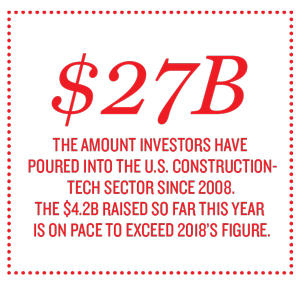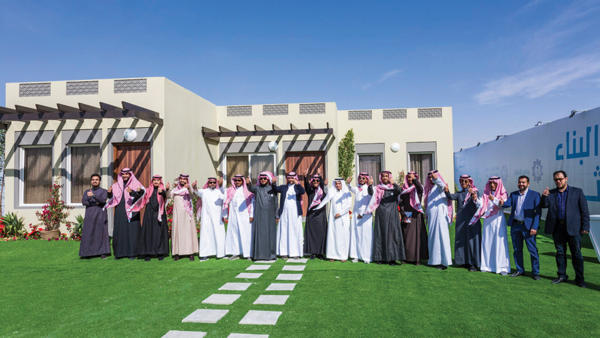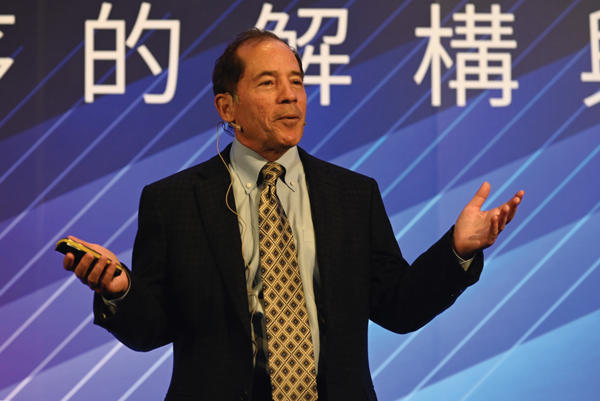Katerra CEO Michael Marks strolled onto the Las Vegas stage, his name and title projected onto a giant black screen. In a style that’s become a cliché among Silicon Valley startups, he was about to unveil the construction firm’s new products to an audience of more than 200 people.
“We’ve been working hard, quietly behind the scenes for the last few years,” Marks said at the February event. “This is our coming-out party.”
At the time, the company had every reason to be a confident debutante: Just one month earlier, SoftBank Group’s Vision Fund had committed another $700 million to the startup — bringing the firm’s rumored valuation to more than $4 billion.
And since it opened its doors in 2015, the unicorn has grown rapidly through a series of acquisitions, reaching a staff of 8,000 globally and doubling down on cutting-edge forms of construction, including prefabrication and buildings made of engineered wood.
The company’s meteoric rise, however, hasn’t been without growing pains.
In its four years, Katerra, which is headquartered in the San Francisco Bay Area, has already had three CEOs and is now on its third chief financial officer. And according to a story late last month on the news site the Information, the company has pulled out of “at least half a dozen apartment and hotel projects in the U.S.”
The Information also reported that the company has laid off more than 100 staffers in three states.
Like other SoftBank-backed startups, including WeWork and Compass, Katerra has yet to turn a profit and has ambiguous plans for an initial public offering. And with WeWork’s recent implosion — the company abandoned its planned IPO and saw its valuation slashed by nearly $40 billion — Katerra and the other companies SoftBank has bet big on are facing heightened scrutiny.
 SoftBank declined to be interviewed for this story, but told the Information that the company is approaching $2 billion in revenue this year. Marks, meanwhile, noted that SoftBank is not the company’s only investor — Foxconn and venture capital firm DFJ have also backed the company.
SoftBank declined to be interviewed for this story, but told the Information that the company is approaching $2 billion in revenue this year. Marks, meanwhile, noted that SoftBank is not the company’s only investor — Foxconn and venture capital firm DFJ have also backed the company.
Katerra, he said, plans to turn a profit sometime in 2020 and is sufficiently capitalized, meaning it doesn’t need to go public, though it may do so after 2021. Marks said it’s healthy that WeWork’s issues have triggered introspection among other companies, but he argued that Katerra’s strategy doesn’t need revision.
“I don’t feel one iota of additional pressure,” Marks told The Real Deal in an interview. “We’re not at all like WeWork.”
Still, some sources said WeWork’s struggles could reflect poorly on the construction startup.
Miles Tabibian, co-director of real estate and construction at early-stage tech investor Plug and Play, said there’s already anxiety over tech valuations in Silicon Valley.
“There are always detractors,” he said. “I don’t think WeWork helped.”
At the same time, Katerra is taking on a sector in real estate that’s been one of the slowest to adopt technology. While the company’s strategy of being a one-stop shop — a designer, supplier and builder — allows it to ensure new technology is used at every layer of the construction process, it also means the firm is taking on far more risk both in terms of capital and liability.
John Fish, the CEO of Suffolk Construction, conceded that the construction industry has failed to embrace technology and is facing mounting pressure to evolve as a possible recession looms and costs rise — driven in part by the U.S.-China trade war. But, he said, VC-backed firms don’t necessarily have all the answers.
“The industry is at a crossroads,” he said. “[But] I don’t think Katerra’s strategy is a panacea for driving costs to the bottom.”
An unimaginative space
Until recently, the details of Katerra’s plans to become profitable might not have mattered much. But that may no longer be the case for companies that SoftBank has showered with cash.
“Given what happened with WeWork, profitability is going to become an issue. I would think before Katerra tried to go public, they’ll have to become profitable,” said Frank Sciame, head of the eponymous construction and development company.
Sciame, however, seemed to draw a distinction between the two startups.
“WeWork is in a class of its own,” he said. “They really were trying to redefine the real estate world.”
Katerra hasn’t faced the same level of scrutiny that WeWork and Compass have, but it doesn’t have as much direct competition as those firms.
Architect Michael Green — whose eponymous firm was acquired by Katerra last year — called WeWork a “completely different animal.” The co-working firm is more of a traditional landlord than a tech company.
In addition, Green said the $1 trillion-plus-a-year U.S. construction industry is due for disruption and noted that very few firms have the financial capability to make that happen.
“The space is such an empty, vacuous, unimaginative environment that those who do invest enough to be able to step in at scale are probably those who reap the benefits the most,” said Green, whose firm focused on buildings designed with mass timber. “I think it’s hard to compare a construction tech company to a traditional tech company in any way because you need more money, but you also have access to a lot bigger profitability down the road.”

Katerra built a 1,334-square-foot home in 48 hours in Saudi Arabia and won a contract there to construct 4,101 homes nationwide
Katerra has, indeed, been buoyed by soaring interest in construction-focused tech.
Since 2008, investors have poured more than $27 billion into the sector in the U.S., according to the global consulting firm McKinsey & Company. In the first half of this year, investment in the sector totaled $4.2 billion, putting 2019 on pace to exceed 2018’s $6.1 billion, according to the Wall Street Journal.
Katerra appears to be the dominant fundraiser in the space, though other unicorns have emerged. Procore, a construction management software company, is valued at $3 billion, and Uptake — which uses artificial intelligence to monitor repair needs at buildings — is valued at $2.3 billion.
Jeevan Kalanithi, CEO of OpenSpace — a company that uses artificial intelligence to create 360-degree, navigable maps of construction sites — said there’s an opening right now to change the landscape as a younger generation steps in and the industry copes with a shortage of skilled workers.
“The industry lost 1 million people as a result of the 2008 financial crisis, and it never really came back,” said Kalanithi, whose firm has raised $17.5 million and is working with Tishman Speyer on the Spiral office tower in Manhattan.
Still, the construction tech sector has some maturing to do.
Kelly Benedict, head of Lendlease’s innovation department in North America, said there’s been a deluge of flashy new tools that, while impressive, amount to a “bunch of solutions looking for problems to solve.”
“There’s a graveyard of failure,” she said. “What tech is getting traction, what is emerging and what’s really going to stick?”
And traditional firms, like Lendlease, are also getting in on the action, either by launching their own tech-focused initiatives or investing in startups. Developers have also started doing more in-house. JDS Development, for instance, does its own construction, and the Related Companies owns a construction management arm and a glass manufacturing firm.
Among construction tech companies, there have been two main strategies: Either focus on one discrete problem — such as safety hazards on construction sites — or take on the entire construction process.
 Katerra has favored the latter approach. In the past two years, the company has acquired at least eight construction, architecture and supply firms.
Katerra has favored the latter approach. In the past two years, the company has acquired at least eight construction, architecture and supply firms.
Katerra has more than 300 projects in its pipeline and, as of October, it had 22 U.S. projects under construction where it’s serving as the designer, supplier and general contractor. These projects include the Catalyst Building, a five-story timber office property in Washington state; a 97-unit multifamily project in Hayward, California; and Fort Apache, a 192-unit multifamily project outside Las Vegas. (It has yet to take on a project in New York City).
In September, the company opened its own factory for cross-laminated timber (CLT) — billed as an environmentally friendly alternative to concrete and steel — in Washington. It’s now manufacturing wooden components for buildings up to 18 stories.
Green said that the public’s comfort level with CLT has grown exponentially over the last few years, but there’s still a long way to go in educating key players about the material. In New York, for example, such structures are still limited to seven stories.
Mihir Shah, co-CEO of JLL Spark — the venture capital and innovation arm of the commercial brokerage — said Katerra’s soup-to-nuts strategy makes sense for a fragmented industry like construction.
“In order to get something efficient, you have to get all members of the ecosystem to adopt technology,” said Shah, which isn’t invested in Katerra. “That’s why Katerra is taking a different approach. It’s like ‘You know what? We’ll be all parts of the stack.’ In construction, unless they’re all in that rhythm, it doesn’t really work.”
“They’ve basically bought every part of the ecosystem so they can do it all and experiment well,” Shah added.
Startup growing pains
Katerra was founded by three tech and finance veterans: Marks, Fritz Wolff and Jim Davidson.
Marks served as CEO of electronics company Flextronics (now called Flex) — which handles multiple aspects of the manufacturing and design of products — and did a stint as CEO of Tesla before founding private equity firm Riverwood Capital. Wolff was a top exec at his family’s real estate private equity firm, the Wolff Company. And Davidson founded tech investment management company Silver Lake.
Part of the impetus for launching Katerra, Marks said, was a suggestion from Wolff, a longtime friend and partner, to create another company that was vertically integrated like Flextronics.
“He said, ‘What you should do is you should create a Flextronics for the construction industry,’” Marks recounted.
In Katerra’s early days, the firm billed itself as a smart home-construction company. But by 2017, it was referring to itself — first and foremost — as a technology company. That’s perhaps not surprising for a SoftBank-backed company: Compass and WeWork have adopted similar branding strategies.
Marks acknowledged that identifying as a tech-forward company is in vogue, but he said that in Katerra’s case, it’s not just lip service. He noted that Katerra has more than five dozen patents and develops custom robotics and artificial intelligence software. The firm doesn’t just deal with “a drone flying over a site and seeing how much dirt was moved” and then refer to itself as a tech company, he said.
Still, like WeWork and Compass (to a lesser extent), it’s seen significant executive turnover. Marks replaced the company’s second CEO, Brad Knight, two years ago. In September, Katerra tapped its third CFO, Matthew Marsh.

Marks said the changes, along with the layoffs, were made as part of the company’s growth strategy. “I think that’s healthy and natural. It’s not a sign of distress,” Marks said. “You don’t go from 0 to 8,000 [employees] without needing to make some changes in personnel.”
The Information reported, however, that on several projects, the company’s all-in-one model “couldn’t save as much money on construction as initially thought” and that there were cost overruns on dozens of projects.
Katerra focuses on offsite construction, meaning that while it manufactures prefabricated parts, the components are assembled at the building site.
Daniel Timianko of Brooklyn-based FullStack Modular, which acquired Forest City’s modular operations in 2016, said that while Katerra is using new materials (wood) and manufacturing its own supplies, it employs a fairly traditional construction process.
While FullStack delivers an entire building superstructure that essentially snaps into place, Katerra provides prefabricated parts that are installed piecemeal.
“What happens on the site is exactly the same as a general contractor. They are not disrupting the onsite construction trade,” he said. “They are using wood, so Katerra can’t build a skyscraper. We can.”
Modular construction has started to gain momentum in New York — the city is using it for affordable housing construction. But the method is far from mainstream, and one high-profile project that did use it, the B2 Tower at Forest City’s Pacific Park, was plagued with delays and other issues.
But Katerra has demonstrated that its approach can lead to efficiencies.
In May, it inked a contract with Saudi Arabia to build 4,101 homes nationwide. The deal came after it won a contest to build a 1,334-square-foot home in 48 hours.
Go big or go home
In January 2018, Marks appeared on CNBC to discuss the $865 million funding round Katerra had just closed. At the time, SoftBank, which led the round, valued the firm at $3 billion. “We were actually hoping for a bigger valuation, but it’s fair,” he said.
A year later, SoftBank’s additional $700 million brought that number up to over $4 billion. And some have reported that it’s valued at $5 billion.
But whether Katerra’s valuation will stand is a question that at least some are asking.
Public relations executive Ed Zitron, who founded the San Francisco-based tech-focused PR firm EZPR, said Katerra seems to have fallen into a “big sexy Valley trap,” noting that it’s raised a ton of money and is spending rapidly but has been forced to lay off staff. From a branding standpoint, he said Katerra and other companies need to stop following the “WeWork template.”
“When there are comparables to WeWork, which are spending a lot of money without being profitable, laying off people, that’s when you start saying, ‘Huh, maybe there is a consistency with SoftBank’s investments,’” said Zitron. “If they don’t want to be associated with WeWork, maybe they should stop looking like WeWork.”
Jake Fingert, general partner at real estate venture firm Camber Creek, which isn’t invested in Katerra, said a highly capitalized company like Katerra poses a potential investment risk. The economics just don’t make sense yet, he said, noting that it will take a while for the firm to reach a scale where its massive investment in factory space is surpassed by revenue. Still, he said that Katerra has an edge because it has “patient capital in its corner.”
“Having deep pockets and the ability to wait that out, in itself, is an advantage,” he said.
And JLL’s Shah said future investors are not likely to be too deterred by WeWork’s recent problems, especially if Katerra shows a long-term profitability plan.
“I don’t think you can get too bent out of shape by one or two examples,” he said. “If you come to [Silicon Valley], are people a little more cautious? Are they thinking about profitability for later-stage growth? I think that’s true.”
Zach Aarons of MetaProp, also a proptech venture firm, said that while he doesn’t have direct knowledge of Katerra’s finances, companies that raise a ton of capital are playing “a numbers game” that threatens to “totally obliterate your ability to have a successful exit other than an IPO.” He noted that WeWork’s potential IPO raised questions about what it would trade at compared to a traditional real estate company. Katerra could face a similar challenge when it goes to market.
“When you think about Katerra, if they are trying to be a GC or they’re trying to be a lumber mill, what premium would they fetch as it relates to the valuation multiple?” he said. “It creates a go big or go home dynamic.”

